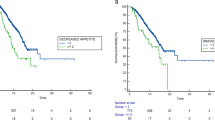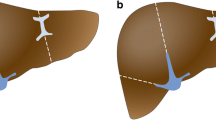Abstract
Objectives
To identify clinical prognostic and predictive factors in patients with hepatocellular carcinoma (HCC) and portal vein tumor thrombus (PVTT) undergoing sorafenib plus transarterial chemoembolization (TACE) and establish a prognostic score for these patients.
Methods
Between January 2012 and December 2017, 184 consecutive patients with HCC and PVTT were concurrently treated with sorafenib and TACE. Univariate and multivariate analyses were performed to explore the clinical factors independently correlated with overall survival (OS). A prognostic score was then developed to identify different prognoses in an initial cohort and validated in an external cohort (n = 72).
Results
In the multivariate analysis, performance status, extension of PVTT, initial radiological response, and sorafenib-related dermatologic toxicity were identified as predictors associated with OS. These factors were used to develop a prognostic score (PPRD score, range from 0 to 11). The median survival was found to decrease as the PPRD score increased, and patients were stratified into a favorable group (0 points), intermediate group (1–4 points), and dismal group (> 4 points). The median survival of patients in the three groups was 34.0 months, 20.0 months, and 7.0 months, respectively (p < 0.001). Additionally, the time to progression (TTP) (p < 0.001) was stratified along the same prognostic groups. The external validation cohort confirmed the prognostic scores.
Conclusions
The proposed score system can accurately stratify the outcomes of patients with HCC and PVTT treated with sorafenib plus TACE to help identify which group of patients may benefit from treatment.
Key Points
• The survival benefits of patients with advanced HCC treated with sorafenib plus TACE remains controversial.
• The independent factors associated with survival were identified to develop a prognostic score, called the PPRD score (standing for performance status, PVTT grade, radiological response, and sorafenib-related dermatologic toxicity); the median survival decreases as the score increases.
• The scoring system can accurately stratify the survival benefits of patients with HCC and PVTT treated with combination therapy and help to identify which group of patients may benefit from the treatment.

Graphical abstract




Similar content being viewed by others
Abbreviations
- AE:
-
Adverse event
- AFP:
-
Alpha-fetoprotein
- BCLC:
-
Barcelona Clinic Liver Cancer
- CI:
-
Confidence interval
- CR:
-
Complete response
- CT:
-
Computed tomography
- CTCAE:
-
Common Terminology Criteria for Adverse Events
- EASL:
-
European Association for the Study of the Liver
- ECOG:
-
Eastern Cooperative Oncology Group
- HCC:
-
Hepatocellular carcinoma
- HFSR:
-
Hand-foot-skin reactions
- HR:
-
Hazard ratio
- mRECIST:
-
modified Response Evaluation Criteria in Solid Tumors
- MRI:
-
Magnetic resonance imaging
- OS:
-
Overall survival
- PD:
-
Progressive disease
- PR:
-
Partial response
- PVTT:
-
Portal vein tumor thrombus
- SD:
-
Stable disease
- TACE:
-
Transarterial chemoembolization
- TTP:
-
Time to progression
References
Siegel R, Naishadham D, Jemal A (2012) Cancer statistics, 2012. CA Cancer J Clin 62:10–29
European Association for the Study of the Liver (2012) Clinical practice guidelines management of hepatocellular carcinoma. J Hepatol 56:908–943
Liu PH, Huo TI, Miksad RA (2018) Hepatocellular carcinoma with portal vein tumor involvement: best management strategies. Semin Liver Dis 38:242–251
Llovet JM, Bustamante J, Castells A et al (1999) Natural history of untreated nonsurgical hepatocellular carcinoma: rationale for the design and evaluation of therapeutic trials. Hepatology 29:62–67
Kulik LM, Carr BI, Mulcahy MF et al (2008) Safety and efficacy of 90Y radiotherapy for hepatocellular carcinoma with and without portal vein thrombosis. Hepatology 47:71–81
Llovet JM, Ricci S, Mazzaferro V et al (2008) Sorafenib in advanced hepatocellular carcinoma. N Engl J Med 359:378–390
Cheng AL, Kang YK, Chen Z et al (2009) Efficacy and safety of sorafenib in patients in the Asia-Pacific region with advanced hepatocellular carcinoma: a phase III randomised, double-blind, placebo-controlled trial. Lancet Oncol 10:25–34
Abou-Alfa GK, Shi Q, Knox JJ, et al (2019) Assessment of treatment with sorafenib plus doxorubicin vs sorafenib alone in patients with advanced hepatocellular carcinoma: phase 3 CALGB 80802 randomized clinical trial. JAMA Oncol [Epub ahead of print]
Zhu AX, Rosmorduc O, Evans TR et al (2015) SEARCH: a phase III, randomized, double-blind, placebo-controlled trial of sorafenib plus erlotinib in patients with advanced hepatocellular carcinoma. J Clin Oncol 33:559–566
Kudo M, Imanaka K, Chida N et al (2011) Phase III study of sorafenib after transarterial chemoembolization in Japanese and Korean patients with unresectable hepatocellular carcinoma. Eur J Cancer 47:2117–2127
Park JW, Koh YH, Kim HB et al (2012) Phase II study of concurrent transarterial chemoembolization and sorafenib in patients with unresectable hepatocellular carcinoma. J Hepatol 56:1336–1342
Lencioni R, Llovet JM, Han G et al (2016) Sorafenib or placebo plus TACE with doxorubicin-eluting beads for intermediate stage HCC: the SPACE trial. J Hepatol 64:1090–1098
Giorgio A, Merola MG, Montesarchio L et al (2016) Sorafenib combined with radio-frequency ablation compared with sorafenib alone in treatment of hepatocellular carcinoma invading portal vein: a Western randomized controlled trial. Anticancer Res 36:6179–6183
Chen SW, Lin LC, Kuo YC, Liang JA, Kuo CC, Chiou JF (2014) Phase 2 study of combined sorafenib and radiation therapy in patients with advanced hepatocellular carcinoma. Int J Radiat Oncol Biol Phys 88:1041–1047
Zhao Y, Wang WJ, Guan S et al (2013) Sorafenib combined with transarterial chemoembolization for the treatment of advanced hepatocellular carcinoma: a large-scale multicenter study of 222 patients. Ann Oncol 24:1786–1792
Zhu K, Chen J, Lai L et al (2014) Hepatocellular carcinoma with portal vein tumor thrombus: treatment with transarterial chemoembolization combined with sorafenib--a retrospective controlled study. Radiology 272:284–293
Li J, Zhang F, Yang J et al (2015) Combination of individualized local control and target-specific agent to improve unresectable liver cancer managements: a matched case-control study. Target Oncol 10:287–295
Liu L, Chen H, Wang M et al (2014) Combination therapy of sorafenib and TACE for unresectable HCC: a systemic review and meta-analysis. PLoS One 9:e91124
Zhang X, Wang K, Wang M et al (2017) Transarterial chemoembolization (TACE) combined with sorafenib versus TACE for hepatocellular carcinoma with portal vein tumor thrombus: a systematic review and meta-analysis. Oncotarget 8:29416–29427
Park JW, Kim YJ, Kim DY et al (2019) Sorafenib with or without concurrent transarterial chemobolization in patients with advanced hepatocellular carcinoma: the phase III STAH trial. J Hepatol 70:684–691
Chung JW, Park JH, Han JK, Choi BI, Han MC (1995) Hepatocellular carcinoma and portal vein invasion: results of treatment with transcatheter oily chemoembolization. AJR Am J Roentgenol 165:315–321
Spreafico C, Sposito C, Vaiani M et al (2018) Development of a prognostic score to predict response to yttrium-90 radioembolization for hepatocellular carcinoma with portal vein invasion. J Hepatol 68:724–732
Zhang Y, Fan W, Wang Y et al (2015) Sorafenib with and without transarterial chemoembolization for advanced hepatocellular carcinoma with main portal vein tumor thrombosis: a retrospective analysis. Oncologist 20:1417–1424
Zhang YQ, Jiang LJ, Wen J et al (2018) Comparison of α-fetoprotein criteria and modified response evaluation criteria in solid tumors for the prediction of overall survival of patients with hepatocellular carcinoma after transarterial chemoembolization. J Vasc Interv Radiol 29:1654–1661
Yu JI, Park HC (2016) Radiotherapy as valid modality for hepatocellular carcinoma with portal vein tumor thrombosis. World J Gastroenterol 22:6851–6863
Lencioni R, Llovet JM (2010) Modified RECIST (mRECIST) assessment for hepatocellular carcinoma. Semin Liver Dis 30:52–60
Kim BK, Kim SU, Kim KA et al (2015) Complete response at first chemoembolization is still the most robust predictor for favourable outcome in hepatocellular carcinoma. J Heaptol 62:1304–1310
Adhoute X, Penaranda G, Naude S et al (2015) Retreatment with TACE: the ABCR SCORE, an aid to the decision-making process. J Hepatol 62:855–862
West H, Jin JO (2015) Performance status in patients with cancer. JAMA Oncol 1:998
Tandon P, Garcia-Tsao G (2009) Prognostic indicators in hepatocellular carcinoma: a systematic review of 72 studies. Liver Int 29:502–510
Peng Z, Wei M, Chen S et al (2018) Combined transcatheter arterial chemoembolization and radiofrequency ablation versus hepatectomy for recurrent hepatocellular carcinoma after initial surgery: a propensity score matching study. Eur Radiol 28:3522–3531
Liu D, Liu F, Xie X et al (2020) Accurate prediction of responses to transarterial chemoembolization for patients with hepatocellular carcinoma by using artificial intelligence in contrast-enhanced ultrasound. Eur Radiol 30:2365–2376
Yang Z, Zou R, Zheng Y et al (2019) Lipiodol deposition in portal vein tumour thrombus predicts treatment outcome in HCC patients after transarterial chemoembolisation. Eur Radiol 29:5752–5762
Lau WY, Yu SC, Lai EC, Leung TW (2006) Transarterial chemoembolization for hepatocellular carcinoma. J Am Coll Surg 202:155–168
Vincenzi B, Santini D, Russo A et al (2010) Early skin toxicity as a predictive factor for tumor control in hepatocellular carcinoma patients treated with sorafenib. Oncologist 15:85–92
Zhong BY, Ni CF, Chen L, Zhu HD, Teng GJ (2017) Early sorafenib-related biomarkers for combination treatment with transarterial chemoembolization and sorafenib in patients with hepatocellular carcinoma. Radiology 284:583–592
Zhao Y, Li H, Bai W et al (2016) Early sorafenib-related adverse events predict therapy response of TACE plus sorafenib: a multicenter clinical study of 606 HCC patients. Int J Cancer 139:928–937
Otsuka T, Eguchi Y, Kawazoe S et al (2012) Skin toxicities and survival in advanced hepatocellular carcinoma patients treated with sorafenib. Hepatol Res 42:879–886
Bruix J, Cheng AL, Meinhardt G, Nakajima K, De Sanctis Y, Liovet J (2017) Prognostic factors and predictors of sorafenib benefit in patients with hepatocellular carcinoma: analysis of two phase III studies. J Hepatol 67:999–1008
Acknowledgments
We would like to thank Shiting Feng (Department of Radiology, the First Affiliated Hospital, Sun Yat-sen University, Guangzhou, China) for imaging assistance, and Jinjian Chen (School of Public Health, Southern Medical University, Guangzhou, China) for statistical assistance in the manuscript.
Funding
The authors state that this work has not received any funding.
Author information
Authors and Affiliations
Corresponding authors
Ethics declarations
Guarantor
The scientific guarantor of this publication is Yong Chen (Division of Vascular and Interventional Radiology, Department of General Surgery, Nanfang Hospital, Southern Medical University, Guangzhou, China).
Conflict of interest
The authors of this manuscript declare no relationships with any companies, whose products or services may be related to the subject matter of the article.
Statistics and biometry
Jinjian Chen (School of Public Health, Southern Medical University, Guangzhou, China) kindly provided statistical advice for this manuscript.
Informed consent
Written informed consent was waived by the Institutional Review Board.
Ethical approval
Institutional Review Board approval was obtained.
Study subjects or cohorts overlap
Some study subjects or cohorts have not been previously reported.
Methodology
• retrospective
• observational
• multicenter study/performed at two institution
Additional information
Publisher’s note
Springer Nature remains neutral with regard to jurisdictional claims in published maps and institutional affiliations.
Electronic supplementary material
ESM 1
(DOC 79 kb)
Rights and permissions
About this article
Cite this article
Zhang, Y., Miao, H., Xie, W. et al. The PPRD score stratifies patients with hepatocellular carcinoma and portal vein tumor thrombus treated with sorafenib plus transarterial chemoembolization. Eur Radiol 31, 232–243 (2021). https://doi.org/10.1007/s00330-020-07078-z
Received:
Revised:
Accepted:
Published:
Issue Date:
DOI: https://doi.org/10.1007/s00330-020-07078-z




